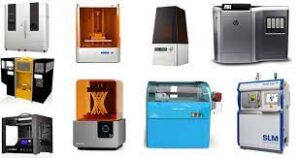In the fast-paced world that we live in, it is highly unlikely that you haven’t come across a single person asking you “Have you seen the new and enhanced 3D modeling technology?” This has happened due to the recent advances in the fields of machinery, software, and of course, materials. It has grown so fast that there are many different types of 3D printers available.
A technology that has been around since the late 1980s is now at the peak of its popularity for its accessibility on professional, low-cost desktops. The ease of accessibility has allowed businesses to accelerate innovation and make huge strides in the domains of audiology, dentistry, education, engineering, jewelry, and manufacturing.
Before we move onto the nitty-gritty details of 3D printers, we first need to analyze the different types of 3D printers and ensure your specific needs for buying a 3D printer.
Like any other beginner’s guide to 3D printing, we also plan to accurately identify your needs from a 3D printer to help you establish an informed decision. To begin, you will require the following essentials:
The actual 3D printer, of course!
A filament material that will help you produce another different material.
An extruder that will help your 3D printer add a unique touch to its production.
A nozzle is an outlet for the filament when it has been fashioned by the extruder.
A stepper motor to allow the printer to move the parts of the device.
Lastly, a software program that can review the layouts of your designs and help the 3D printer to produce them accurately.
If you’re looking out for the most popular 3D technology, choose fused deposition modeling. For its affordability of coming in low-cost 3D printers and even 3D pens, FDM is crowned as the first-choice 3D printer option in any 3D printer guide.
FDM is famous for using production-grade thermoplastics, which allows the produced materials to contain efficient and sturdy chemical, mechanical, and thermal properties. Printing time on the FDM technology is purely dependent on the complexity of the work.
Stereolithography is one of the few 3D printing technologies that have been around since the advent of 3D printing. Its ease of usability allows you to design your desired prototypes and bring your imaginative 3D models to life.
SLA printers share no similarity to the standard desktop printers. They operate with an excess amount of liquid plastic which has the tendency to solidify after a while and mold into the desired shape.
The time required to print a 3D project using an SLA printer depends upon the size of the SLA printer.
Digital Light Processing is a 3D printing technology that shares some similarities to the SLA printing technology. It uses digital micromirrors laid out on a semiconductor chip.
The DLP printing technology consists of an LCD panel that can be applied to the entire surface of the 3D printed layer when running the DLP procedure. Then, it uses a specialized liquid-plastic resin that is stored in a transparent resin container.
The element that makes DLP faster is the liquid plastic resin that has the tendency to harden quickly when exposed to bright light. This kickstarts the printing speed of DLP, making the first hardened surface of a material in a matter of minutes.
While these are the best kinds of common 3D printing technologies available on the market, if you wish to make an even more informed decision before making a suitable purchase, then it’s a good idea to do a bit of research. Information at https://io3dprint.com/ goes over the different options available, which will ultimately allow you to make a more informed decision. Once you gain a better understanding of each printer available, you’ll know which one would suit your needs best.
Source : https://www.mikegingerich.com/blog/different-types-of-3d-printers-and-how-to-choose/









